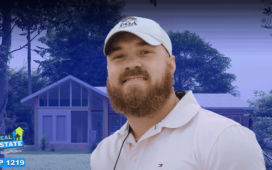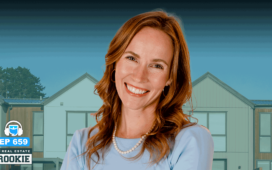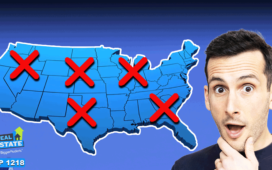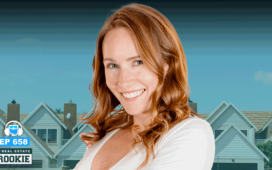This investor generates $30,000 per month in rental income from a single property. It’s not a short-term rental, or a beachside Airbnb, or anything even close to that. Within a couple of years of starting to scale, James Davis has a rental portfolio on track to gross $1,000,000 per year in rents, from just six properties. The best part? He’s not even doing it for the money. His investments are making lives better while securing him financial freedom.
You may have heard of assisted living before, but probably not like this. While many assisted living facilities focus on older adults, James owns small assisted living properties that cater to individuals with disabilities. After taking on two traditional real estate deals, James’s brother, who worked in disability services, thought they could be treating residents better. So, they converted one of James’s properties into a compliant assisted living facility. They got their first monthly tenant—the rent: $15,000 per month for one bedroom.
Sounds steep, right? James walks through the entire expenses and profit margins to prove that the caregiving business may be worthwhile, even just for the emotional benefits. Now, he has six properties and has already pulled in $500,000 just halfway through the year. Follow the same steps James shares in this episode, and your portfolio could grow just as fast.
Dave Meyer:
This investor makes $30,000 per property per month with assisted living rentals. Is there really no cashflow available for real estate investors these days, or do you just need to get more creative instead of making excuses during a challenging market? Today’s guest found a formula that tripled his monthly revenue, and now he’s repeating it over and over to grow his portfolio and advance towards financial freedom. Hey everyone, it’s Dave head of Real Estate investing at BiggerPockets, and I’ve been buying rental properties for more than 15 years. Today I am joined on the show by an investor, James Davis from Salt Lake City, Utah. And James started his investing career with just $15,000 in savings and was willing to do anything including living without a toilet for three months just to make his first deal work. Now, just six years later, he owns six properties and is on pace to gross more than $1 million in revenue.
This year. James has done this by adopting the increasingly popular assisted living real estate strategy. Basically, what he does is provide a needed service to people in his community, and by doing that, he can generate up to $15,000 in revenue from just a single bedroom in a house that would normally rent for just 2000 bucks. This approach is definitely an active strategy, and so it’s not going to be for everyone, but if you’re willing to hustle as much as James has, you can radically transform your financial situation in just a couple of years. Keep listening and hear how he’s doing it. James, welcome to the BiggerPockets podcast. Thanks for being here.
James Davis:
Thanks for having me.
Dave Meyer:
So how long have you been investing or involved in real estate, James?
James Davis:
I got my first property, it was September of 2019, so it’d be almost six years ago.
Dave Meyer:
Nice. Okay, and can I ask why? What brought you into the world of real estate?
James Davis:
So I’ve always loved watching you guys. I really liked Graham Steffen and meet Kevin online. Sure,
Dave Meyer:
Yeah.
James Davis:
Growing up in high school, I watched those channels, so I think I always wanted to be invested in real estate. It was just a question of when and when I was 18 and I actually moved out of my parents’ place and I was a live-in aide at a nursing home. So what it looked like is I didn’t have to pay any rent.
I got to live there. I take care of this guy. He was a Vietnam War veteran and I took care of him. He paid for my food and housing and I didn’t have to pay anything, which was really nice. So it was a really good setup and my uncle reached out to me, he was a real estate agent, and he was like, Hey, I have this property that I think you should invest it. And in my mind I was like, oh, I don’t pay any rent. I could live here for a while. I’ll just save more money. I don’t need to buy a property right now. And that was July of 2019. So he was suggesting like, Hey, just use your savings. You’ll have a down payment. It was like a house hack situation where I’d live in the basement and I had a separate entrance, and then I’d rent out the upstairs, but it would be like $15,000, which was everything I had. So I decided, okay, yeah, I want to take this on. That was July, August of 2019, and it was actually a seller finance.
James Davis:
Oh, cool.
James Davis:
And this is my uncle setting it all up. I had no idea any of real estate contracts or anything, how that worked, and I had just graduated high school.
Dave Meyer:
It sounds like you walked into an interesting opportunity with your uncle. So he came up with this house hack. I’m curious, a great way to get started, especially in 2019. I’m sure it worked out well, but did you look at other deals or were you kind of just trusting your uncle? Like this one that he’s proposing to me, it’s seller financing. This is a good deal.
James Davis:
Yeah, I didn’t look at anything else. I had complete trusted him, and looking back, I’m like, wow. I was lucky, and I’m fortunate that I had someone in my life that cared about me and didn’t take advantage of me. He totally could have.
Dave Meyer:
Sure.
James Davis:
Yeah.
Dave Meyer:
But so was it in a neighborhood you liked? Did you know where it was or you just kind of moving into a house blindly based on your uncle’s recommendation?
James Davis:
When I went to the neighborhood, of course it wasn’t the most expensive side of town, but it wasn’t terrible either. We call it West Valley over here.
Dave Meyer:
Okay, cool. And so you find this house hack, you got to put 15 grand in, that’s all of your life savings at this point. Oh, yeah. But you’re moving from what was your job, right? Because living with this veteran you were living with was kind of how you were getting income. So did you have a new plan for how you were going to make your mortgage payments or were you living for free
James Davis:
At the time? I was making 16 bucks an hour at a call center.
Dave Meyer:
Oh, wow. And then you were doing DIY renovations to it at the same time?
James Davis:
Oh, yeah. And this is at the time where I had no idea what I was doing either. And what I had done is I lived in the basement, it had that separate entrance. There was no kitchen, not even a bathroom down there. And then I rented the upstairs right away.
Dave Meyer:
Okay, but how did you go to the bathroom?
James Davis:
It was funny. I had a gym membership and I had to strategically do that and I worked downtown at the call center, so I would go to the gym, not to work out or anything. I would just go there to take a shower,
Dave Meyer:
Just to use the shower
James Davis:
And then do everything and then go to work that way.
Dave Meyer:
Oh, wow.
James Davis:
I didn’t have a toilet for three months. Oh my
Dave Meyer:
God.
James Davis:
Yeah. I didn’t have a toilet, I didn’t have a shower, and that was my first goal was to try to get that.
Dave Meyer:
Well, I imagine that’s pretty motivating for when you’re doing your DIY. It’s like I got to build myself a toilet at least.
James Davis:
And then on top of that, so I had the down payment for 15 and I knew I needed about 15 or so in work, and I ended up spending about $12,000 on the renovations. I did all of it on my own.
Dave Meyer:
And how’d you pay for that? Was that just more savings or your income from your job?
James Davis:
It was my income from my job. Every paycheck. I just threw it at Home Depot basically going and getting materials and doing everything. Of course, I knew how to do something, but then I had to wait until I could buy what I needed to buy, which was really tough, especially with the mental load of the balloon payment coming due
Dave Meyer:
For sure.
James Davis:
My uncle was like, Hey, if you don’t finish it in a year, it’s due. And if it doesn’t appraise, then you can’t keep the house basically. So
Dave Meyer:
Everyone understands. Sometimes when you do a seller finance deal, the seller will say, Hey, yeah, I’ll float you for a year, but I’m not going to amortize this loan over 30 years like a bank. They’re basically like, I’ll give you a year to figure this out, but in a year you owe me all your money. And that’s sort of in the form of a balloon payment. And so what James was facing is that in a year he had to figure out a way to refinance, or I guess the seller could technically foreclose on you or try to take the property back, but you’re also dealing with this thing, you want to go quickly to renovate, so you can refinance, but you’re using money from your call center job to pay for that. So how long did it actually wound up taking you before you could complete the renovation and get that refi?
James Davis:
It took me eight months, and I think it probably would’ve gotten done in two, maybe if I had the money right away. But I had to do a just paycheck by paycheck. I added a kitchen down there, I added a bathroom, I did all the plumbing, the electrical, everything.
Dave Meyer:
And you taught yourself all that?
James Davis:
Yeah. There’s a really good book. I think it’s called Home Improvement 1, 2, 3. It’s something from Home Depot. Actually, my uncle recommended it and I read it and it shows all the basic stuff if you didn’t want to go through YouTube, but I used YouTube a ton, and even though it was really hard, I remember being very happy at the time and just being like, I know that this will help me in the future. I just got to get it done, put my head down and work on it. I didn’t even have a bed. I had a sleeping bag that I was sleeping on. There was no flooring. It was a concrete floor and it was just I was the definition of house pour at the time.
Dave Meyer:
Good for you, man. I mean, that is an unbelievable amount of hustle to get it done. You just found an incredibly creative way to get into your first deal and worked your butt off and personal sacrifice for eight full months basically to be able to do that. Not everyone’s going to do it that way, but kudos to you, man. I mean, you took responsibility and you worked your butt off to be able to do that, and hopefully it worked out for you financially. When you were done with the renovation, what did you have? Because you had the unit upstairs now, so what did the final product look like when you went to apply for the refi?
James Davis:
I had an appraiser come in for the refinance and they appraised it, the 2 85, which means the loan to value was 80%, I think.
Dave Meyer:
Nice.
James Davis:
So my mortgage two 20, which means I didn’t have PMI and I got a 3 7 5 interest rate.
Dave Meyer:
That must have felt good.
James Davis:
Yeah, it did. And it was June of 2020 when I closed on the refinance. So I was able to lock in that rate for the 30 years on a conventional loan instead of an FHA, and my payment ended up being 1300 with the PITI.
Dave Meyer:
And how much rent were you getting upstairs?
James Davis:
So during the renovations I charged 1100, but afterwards I was able to do 1300. Amazing. The rent covered my mortgage payment.
Dave Meyer:
So after obviously eight months of incredibly hard work and sacrifice, you were able to essentially live for free. Now your upstairs tenant is paying your principal, your interest, your taxes, and your insurance. So pretty much your biggest costs. I’m sure there was still repairs and other costs, but given that you just did a big renovation, at least the basement unit was probably in pretty good shape. And so that’s just a home run deal. That’s incredible. I hope you still have that 3.85% interest rate on that deal.
James Davis:
Yeah, I do. And it’s still doing really well and just recently appraised for four 40.
Dave Meyer:
Okay, congratulations. Just want to say, this just seems like an absolute home run deal. Congratulations on putting in the effort, the time getting creative, and figuring this out. I want to hear where this first deal has taken you and how you went from living without a toilet for three months to now running a multimillion dollar real estate business in just the span of a couple of years. But first, we got to take a quick break. We’ll be right back. Managing rentals shouldn’t be stressful. That’s why landlords love rent ready. You can get rent in your account in just two days, which means faster cashflow and less waiting. Do you need to message a tenant? You can chat instantly in app so you have no more lost emails or texts. Plus you could schedule maintenance repairs in just a few taps so you’re not stuck playing phone tag. Are you ready to simplify your rentals? Get six months of rent ready for just $1 using promo code BP 2025. Sign up in the link in our bio because the best landlords are using Rent Ready. Welcome back to the BiggerPockets podcast. I’m here with investor James Davis. We heard about this amazing house hack he did in Salt Lake City back in 2019. James, after you pulled off this incredible effort of hustle and creativity, what did you do from there?
James Davis:
Yeah, so actually January of 2021, I left and I served, it was a mission for my church, so I left and I was living in the Detroit area for two years.
So I had family that actually lived in the property and they took care of it while I was gone, while I was there in Detroit. And if anyone knows what a mission is like you don’t really have access to technology or what’s going on in the world, but when I came back two years later, I saw that real estate values had doubled in my area. So my mortgage was around two 20, but yeah, it was around the $400,000 range that it was worth. So I came back February of 2023 and taking the advice from what I’ve heard from BiggerPockets and the other real estate investors, I went and I applied for a heloc. So I got my HELOC approved for a hundred thousand dollars, June of 2023, and then this wholesaler sent me this deal September of 2023 for the single family property that needed a lot of work, but it was a sub two deal. Okay, interesting. The seller didn’t have any equity. They bought it back in 2021, but they had two loans on it, so it was the original mortgage plus they got a loan on their down payment. It wasn’t a pre foreclosure, but it was getting close to that.
Dave Meyer:
And how do you approach that when you see a situation like this, how do you structure a deal that makes sense for you and hopefully for the family that you’re taking the mortgage over for as well?
James Davis:
For this one, what we did, we back paid all those mortgage payments, so I made sure everything was current, and then they got $5,000 too on top of that. So instead of having to come out of pocket, they got $5,000. And I paid for all the closing costs too and the wholesale fee too. And it’s good for them because they’re in this situation, if they tried to sell with an agent, they would have to fix up the property, they’d have to deal with all that, and it would be like a several month ordeal probably,
Dave Meyer:
And probably a 6% commission.
James Davis:
Absolutely. So with a sub two, they don’t have to do that.
Dave Meyer:
Right.
James Davis:
And that’s kind of the selling point because a lot of people don’t know about it, especially the sellers. So when you’re trying to talk to sellers about sub two, you have to say, Hey, you get equity, you get paid to get out of this and you don’t have to deal with the payment anymore. And then if I don’t make the payment, you can have the place back and all the payments I’ve made, you can have that too. So that’s how I’ve structured it. And I think also key is having a really good title company that’s dealt with it before, and you can reach out to title companies and say, Hey, have you ever done sub two deals? Have you ever done seller financing? This is what I’m wanting to do. Have you guys had experience with that? And there’s definitely escrow officers that have more experience than others. So having those people with experience is I think really key
Dave Meyer:
For sure. Yeah, I mean that’s really good advice because with subject two, right, there are risks to both the seller and the buyer. For a buyer, there is a risk that the bank could call the note do. What are the risks to the seller? I guess maybe I should ask you.
James Davis:
Yeah, the risks to the seller is it’s still on their credit. So the loan is still there, so if I don’t make the payment, it could affect them still. So if someone pulls their credit, they still have to explain, Hey, this is a mortgage that yes is under my name, but it’s a substitute and they have to prove that if they were trying to get loans in the future. So there are downsides in that way, but I think the pros outweigh the cons where they can get out of a situation that they really don’t want to be in anymore and they can get paid to be able to get out of it, which is nice because sometimes with properties that need a lot of work, you almost feel like you’re taking advantage of people when you buy them. And I hate feeling that way. I hate feeling like I’m taking advantage of someone’s suffering. But with sub two, I feel like you’re offering a solution for a really tough situation that they’re in and you’re giving them a way out that’s creative that yes, there are risks, but I got their interest rate, which was three and a 5% in 2023.
Dave Meyer:
I think subject two is sort of a controversial thing. I think as long as you understand the risks and sort of go into it with the mentality that James has where you are trying to genuinely help someone and create mutual benefit, as long as you understand the risks, work with professionals, as James said, work with people who really understand this and go in it with an approach of trying to find a mutual benefit. It is a worthwhile strategy for a lot of people to consider. Make sure that you’re not breaking any laws doing anything they think. Right, but if assuming that you can do it right, like you said, you can help someone out and you can get an interest rate. That’s a fraction of what you would get today if you were just to go get a new mortgage.
James Davis:
Absolutely. And with this one specifically, we had reached out to the mortgage company and said, Hey, this is what we want to do.
Dave Meyer:
Oh, that’s great.
James Davis:
Hey, it’s either you have a foreclosure or we make the payments. And they said, okay, yeah, we do need to call the loan due, but we’ll delay it. So they agreed, Hey, we’re going to delay 18 months if the payments are current after a year, you guys can assume the loan.
Dave Meyer:
Okay, that’s a great way to do it.
James Davis:
But of course that was with the mortgage company agreeing to it and being kind enough to delay it, but it was in their best interest too.
Dave Meyer:
That’s a great way to do it and definitely appreciate you really dotting all the i’s crossing all your T’s and doing this the right way. When you were talking to some of these wholesalers, were you intentionally looking for sub two or did you just kind of come into this deal and then figured out sub two? After
James Davis:
I was looking for seller finances, but with the interest rates being higher, it was tough to find a deal that I could cashflow with the numbers because I was wanting to buy and hold and doing the long-term. And that was my idea back then was to buy the long-term rental real estate, but the numbers just couldn’t make sense. So I came across sub two and it kind of came to me, I guess with that first deal as an option.
Dave Meyer:
Well, you’ve proven yourself, James, to be a very creative and hardworking guy just from the first two deals that you’ve told us about. I want to hear more about how you’ve scaled. I understand that you’ve really grown a massive real estate business in the last couple of years, but we do have to take one more break. We’ll be right back. Welcome back to the BiggerPockets podcast. I’m here with investor James Davis. James, it sounds like youDid your first house hack. You did this sub two deal, but since then in the last two years or so you really scaled your business. What have you been up to more recently?
James Davis:
So my brother reached out to me. He was working for a company that did residential and disability services. There’s assisted living for older people, but then there’s assisted living for different categories of people too. We went into the realm of assisted living for people with disabilities that are any age. So my brother reached out saying, Hey, I work for this company. And one, he didn’t really like how it was being run. He was really passionate about the mission where it’s like, Hey, we need housing for people with disabilities. Of course there’s a business side of it, but you should look at this. So he sent me what it could look like and the whole licensing process, and I reviewed it with him and it would be really expensive because one, you have to have a long period of time without a tenant at all where they do tons of inspections and licensing process, and then we have to do so much paperwork.
Dave Meyer:
And you already have to own the property at that point, right?
James Davis:
Yeah, exactly.
Dave Meyer:
So you’re just sitting on a mortgage and insurance and taxes while you’re working with, I assume the government state, local government to figure this out.
James Davis:
Oh yeah. So we’re sitting on it and it’s more like I’m sitting on it and we’re doing the licensing process, and we started that around July, August of 2023. So it was actually before I bought the second property when we started. And it took eight months for the whole licensing process where we had to do all the paperwork and then we finally got approved. Okay, you’re allowed to provide services for these types of people,
But in this industry, at least in the state of Utah, the way it’s set up, it’s similar to being a real estate agent where you have to fight for clients and really show that you can take care of them. Me and my brother, actually, after we got the license and we were finally legal to have clients, we got the list of all the case workers in the state of Utah and called every single one of ’em, and it was like 400 called everyone we’re like, Hey, we’re a newly licensed provider. If you have a resident, we’re ready to take ’em right away. And of that entire list, we got one person. Oh my gosh. So we found a client that toured the place and was like, okay, yeah, I want to live here. And that was our very first one. And at that point, my HELOC was at like $50,000 and me and my wife and my brother, we were all working and we all took shifts. I’m taking care of this person.
Dave Meyer:
Oh my gosh. So it’s really like one-to-one care.
James Davis:
Oh yeah. So it was 24 7, someone had to be there 24 7, so we just took care of ’em. It’s similar to having kind of like an infant where they just need that level of supervision. The good thing is the revenue was closer to $15,000 a month just from this one person,
Dave Meyer:
15,000 a month. And they’re living in one bedroom in your facility?
James Davis:
Just one bedroom. And we were approved for up to three.
Dave Meyer:
Okay. Oh
James Davis:
My gosh. That was the first one. And we took shifts and we didn’t hire anyone because we really wanted to pay down our debt that we had accrued just from the vacancy and then from the renovations too. So we did that for about five or six months, just literally taking 10 12 hour shifts back and forth while we were all working and we just had to work it around our schedules. But after that, we started hiring people and it made it a little bit easier.
Dave Meyer:
I mean, I’m sure there’s a lot of people listening to this thinking 15 grand a month, maybe you can get three tenants at once. It’s 45 grand a month. That’s an incredible amount of money. Tell us just a little bit about the economics about this, because first, are there other expenses? I assume there’s a lot of insurance and stuff that on top of just labor costs, that’s a lot more expensive as well.
James Davis:
Oh yeah. You have to have the highest level of insurance for this industry. You’re taking care of people. So if something goes wrong, the state requires us to be covered. So the insurance requirements are really high. So we pay, it’s about a thousand dollars a month just in insurance. The good thing is, is that as you get more clients, that number kind of stays the same for insurance cost, but when you only have one, it does feel like it’s a lot too. For a $15,000 client, you are looking after all of the expenses, probably like 10 or $11,000 a month in expenses, but you’re probably cashflowing three or $4,000 per person that’s living there.
Dave Meyer:
And just as you scale up, I assume you got more residents over time?
James Davis:
Oh yeah. We have a lot more now. So we only had that one for five months, but then as we were doing well, the caseworkers I guess noticed and they sent us a little bit more. So right now we’re at 13.
Dave Meyer:
13 residents across how many properties?
James Davis:
So we have four properties right now that are active where we have residents there. So there’s residential care, which is that type of assisted living, but then there’s something called supported living where they live in a home and then there’s a staff that comes and takes care of them. So we have six clients that are residential. Then we have the rest that are supported living, so they’re not involved in our real estate portfolio, their business.
Dave Meyer:
So how big is this business grow? What is your revenue now?
James Davis:
So this year we’re set to do $1 million in revenue, maybe even 1.1 million depending on how things go. And then net out of that we should be getting at least $200,000 this year. So right at about a 20% margin.
Dave Meyer:
That’s amazing. Obviously created a business that you can, I would assume comfortably live on, don’t know your living expenses, but based on the stories you’ve told me, I assume that you can comfortably live off of that. Can you break that down? Just how many units is that? How many properties across,
James Davis:
I guess it comes out, it’s about $83,000 a month that we’re getting a total. For the real estate side of things, it’s about $70,000 of our revenue is coming just from the properties that we have. So we have four functioning properties, two of them, it’s about 25 to $30,000 a month, about two residents and each one. And their funding is a little bit different. It’s not always 15. 15 is on the higher end if they need a lot of staffing. So for the first two properties, there’s a 25 to $30,000 a month, and then on the other two they’re just one or two bedroom condos and those pull in $6,000 a month each.
Dave Meyer:
And then the remaining revenue is from sort of the staffing that you do in other people’s properties?
James Davis:
Yeah, exactly. So that would be non-real estate related revenue.
Dave Meyer:
Very cool.
James Davis:
Yeah.
Dave Meyer:
I’m curious if you have any advice for our audience here, because I assume a lot of people are hearing your growth trajectory, your revenue, your profit margin, all super impressive, but you’re also running a more sophisticated business that’s more complicated than buying just a regular rental property and you’re taking care of people. This is a super important role that you are playing. So what kind of investor, what kind of person do you think could succeed with a strategy like yours?
James Davis:
I think if someone wants to have a choice of how they make their money and they still care about people, it is caregiving in a way where you still have to care about the people. It’s not all about the money, even though we wouldn’t be able to do it if there wasn’t any money, but you do need to care about the people. And if you do care about people, you have a way to take care of people and meet your needs. And it’s incredibly satisfying. I remember working at my job and I hated getting up in the morning. I hated going to work. I hated having a boss telling me what to do. I hated having to beg someone for time off and saying like, Hey, I want to go do this. Or feeling sick and still feeling the need to go to work. You have to just suck up to somebody. So someone that doesn’t like being an employee, and I hate being an employee. I hate, and I think I’m a bad employee because of that. I don’t think I’m good at listening to other people.
Dave Meyer:
Well, that’s kind of what I was saying at the beginning. You clearly have this entrepreneurial spirit. Even in high school, if you’re selling stuff on eBay, there’s something about you that wants to take your financial future into your own hands.
James Davis:
Oh yeah. And I feel like a lot of people feel that way. It’s just they don’t have a vehicle to realize that dream. And this is a way to do that where you can use real estate, and I love real estate and a way to fund my lifestyle too and be able to meet my needs and my family’s needs while meeting other people’s needs too.
Dave Meyer:
Yeah, I love that mutually beneficial approach. Thinking about creating a business that obviously works for you and your family, but provides value to the people that you are serving at the same time, you’ve obviously James accomplished a lot in just a couple of years. It’s amazing. What are your goals from here?
James Davis:
Yeah, I think we’re kind of on the upper end of where we want to be, at least on the business side. We might get another property or two because right now we have six and it was really easy to scale and buy more properties when you just have a lot of money coming in. And we didn’t get paid for a really long time because we would just put that money towards down payments and doing more subject twos and doing that. But I think what we would want to do is buy a couple more properties, but we’d still love to have the long-term rental real estate too. I do like the idea of having a tenant that only bothers you every once in a while instead of every day, and you have someone that is really high maintenance, even though there’s more revenue on this side of things. It is nice to have some things really stable
Dave Meyer:
For sure,
James Davis:
Which is what long-term rentals are. So we want to use the revenue that we’re getting and the profit to have higher down payments and just buy really good cashflow, Inc. Real estate.
Dave Meyer:
Makes sense. Yeah, just balance out the portfolio a little bit. Higher revenue, higher work. Some is a little bit lower revenue, but lower work building a sort of portfolio of different properties that have different values, different purposes in your portfolio is I think where most real estate investors want to get. So thank you, James for sharing that with us. And thank you so much for being here and for sharing your story with us. It was really interesting to hear, and I’m sure our audience got a lot out of
James Davis:
It. Yeah, absolutely. Thanks for having me on.
Dave Meyer:
And thank you all so much for listening to this episode of the BiggerPockets podcast. We appreciate you being here, and we’ll see you for another episode in just another couple of days. We’ll see you then.
Help us reach new listeners on iTunes by leaving us a rating and review! It takes just 30 seconds and instructions can be found here. Thanks! We really appreciate it!
Interested in learning more about today’s sponsors or becoming a BiggerPockets partner yourself? Email [email protected].















